Popping my own corny experiment
Turn a fun snack into a scientific investigation
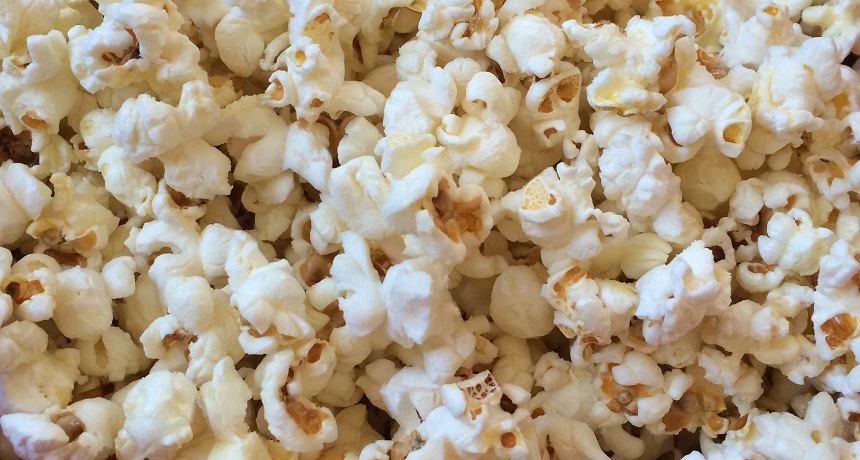
A new study showed that popcorn pops in an oven at 180 °C (356 °F). Here I describe how I attempted to confirm that.
B. Brookshire/SSP
This article is one of a series of Experiments meant to teach students about how science is done, from generating a hypothesis to designing an experiment to analyzing the results with statistics. You can repeat the steps here and compare your results — or use this as inspiration to design your own experiment.
Popcorn is one of my favorite foods. I love its squeaky crunch and the taste of butter and salt. Popping my own corn on the stove top makes me think of relaxing with a book or settling in with a fun movie. And now, it also makes me think of science.
Scientists recently popped corn in a conventional oven to determine at what temperature the kernels explode. Then they invited the rest of us to run tests to confirm that their findings. I took the challenge, but decided to use the stove top. And — spoiler alert — I got a different result! But that doesn’t mean their findings were wrong. And I’ll explain why.
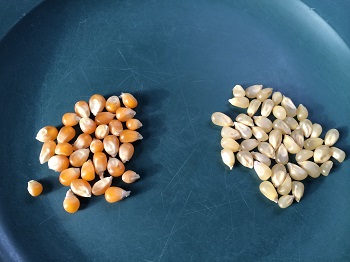
The researchers found that in an oven, corn pops at 180 °C (356 °F). At this temperature, water inside the tough kernels turns to steam. As that steam expands, pressure builds up inside the kernel. Eventually, it forces the tough outer wall of the corn to burst open. The researchers calculated that kernels should pop at the same temperature regardless of size.
But most people don’t pop popcorn in a standard oven. They use a stove top or a microwave oven. That could make a difference.
When corn sits on a baking sheet inside a standard oven, the heat bathes a kernel from all sides. In a pan on the stove, the bottom of the pot (which makes contact with a flame or electric burner) will be far hotter than the air above it. Because a smaller kernel will have a greater surface area, a larger share of it may make contact with the pot’s bottom. And this could mean it heats — and pops — faster.
That was my own hypothesis — an idea that I could test. At my grocery store, the white popcorn’s kernels tended to be smaller than the yellow ones. So I hypothesized that those white kernels should pop first.
What I did
I assembled my equipment: a stove, small scale, pot, cooking oil, timer, infrared thermometer — and, of course, some popcorn. That infrared thermometer measures the heat, or thermal radiation, released from a surface. (Infrared thermometers are easy to find and use. I got mine for less than $20.) Just aim the device at a surface (mine comes with a nice laser to help) and its screen will tell you the temperature of the surface it’s pointed at. It’s a great way to measure the temperature without risking getting your fingers burned.
Next, I weighed out one gram of white corn, and another gram of yellow. Then, I counted how many kernels were in each gram.
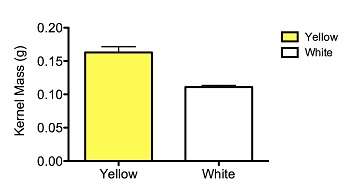
It’s important to run the steps of an experiment — even one as simple as this — many times. If you do it just once, you will never know if the differences you saw between test groups (here white and yellow corn) were likely due to chance. I need to make my measurements enough times to ensure I don’t claim my experiment didn’t work, when really it did. (I also want to make sure I don’t claim my experiment worked when in fact it didn’t.) I consulted a chart (specifically, Table 2 in this link) to find out how many times I would need to run my experiment to find a difference between the kernels, if one really exists. The chart suggested I should weigh each type of corn 26 times.
I wasn’t ready to invest that much time for a short study. So I ran a preliminary experiment — a short trial. It could tell me if my idea might work with more testing. I weighed five different random grams of corn. I counted how many kernels were in each gram. From that, I could determine how much, on average, each kernel weighed. Each yellow kernel was around a sixth of a gram. The white ones were around a tenth of a gram.
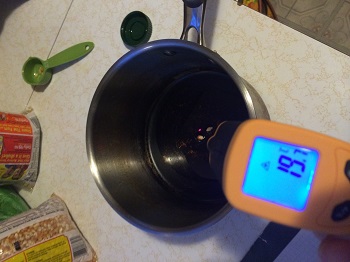
With my infrared thermometer in hand, I put a tablespoon of olive oil in the bottom of a room-temperature pot. Then I placed one kernel of white popcorn and one of yellow in the center of that pot. I was careful to place them very close to each other. I wanted to make sure they would receive equal heat. I cranked up the burner to medium-high and aimed my thermometer at the center of the pot. As I waited for the kernels to pop, I measured and wrote down the temperature every 15 seconds. Finally, I logged the time that each kernel exploded.
Afterward, I did the dishes, made sure the pot was completely cool, and started all over. Again and again, a total of five times. For each color of corn, I summed the five popping times together. Then I divided the sum by five to get the mean — a number that represents the average popping time for each set (color) of corn. I then compared the average time it took for the yellow and the white kernels to pop.
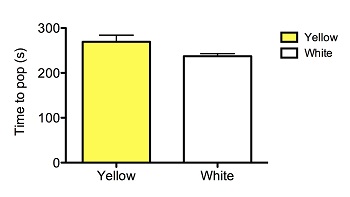
It may look like the yellow corn (in the yellow bar at right) took more time to pop than the white corn. But so far, there still is a possibility that the difference I detected was due to chance. So unless I run these tests another 21 times, I can’t say with any certainty that smaller kernels pop faster than larger ones.
But look at the graph below. Temperature appears on the bottom line. It shows that both the yellow and the white kernels popped when the pot was more than 225 °C on the surface. That’s much higher than the 180 °C the scientists reported in their experiment.
So a pot on the stove needs to get hotter than the oven for the corn to pop. It is possible that the kernels still need to reach an internal temperature of 180 °C in order to explode. But because the pot is in the open air, the pot itself must get hotter before the inside of each kernel reaches 180 °C.
Oh, and yes, my preliminary experiment shows that it is probably worth popping some more corn. The smaller kernels look like they take less time to pop. If I do the experiment 21 more times, I should be able to tell if that difference is real, or if it’s just a lucky guess.
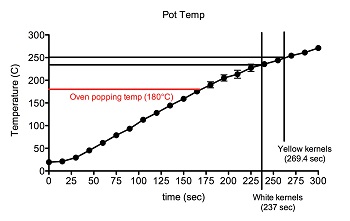
The scientists who wrote the popcorn paper would like many of us to try their experiment. The next time you pop corn on the stove, see if you can measure the temperature of the pot when that first kernel exploded. Was its temperature similar to mine? Or did you get something different? You’ll have to run your experiment many times to make sure your results are consistent. It’s a good excuse to do some science.
And enjoy some popcorn while you’re at it.
Follow Eureka! Lab on Twitter
Power Words
(for more about Power Words, click here)
average (in science) A term for the arithmetic mean, which is the sum of a group of numbers that is then divided by the size of the group.
cellulose A type of fiber found in plant cell walls. It is formed by chains of glucose molecules.
hypothesis A proposed explanation for a phenomenon. In science, a hypothesis is an idea that must be rigorously tested before it is accepted or rejected.
mean (in mathematics) One of several measures of the “average size” of a data set. Most commonly used is the arithmetic mean, obtained by adding the data and dividing by the number of data points.
pressure Force applied uniformly over a surface, measured as force per unit of area.
radiation(in physics) One of the three major ways that energy is transferred. (The other two are conduction and convection.) In radiation, electromagnetic waves carry energy from one place to another. Unlike conduction and convection, which need material to help transfer the energy, radiation can transfer energy across empty space.
statistics The practice or science of collecting and analyzing numerical data in large quantities and interpreting their meaning. Much of this work involves reducing errors that might be attributable to random variation. A professional who works in this field is called a statistician.
thermal Of or relating to heat.